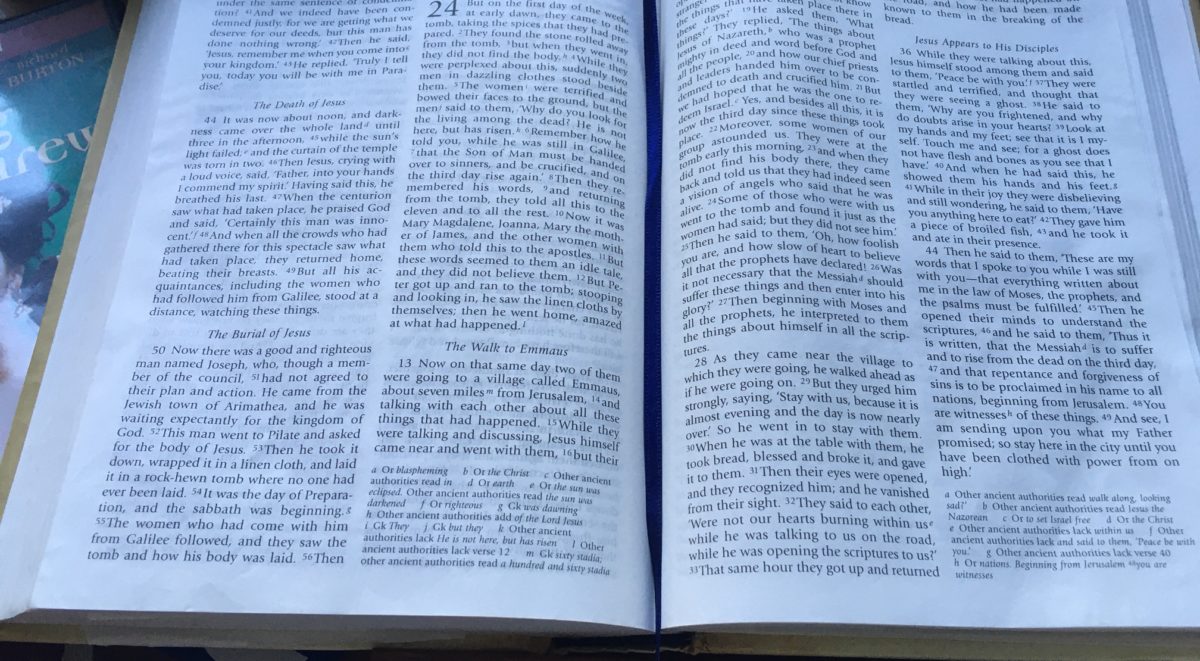
Our brother Fr Bruno is a composer, but his day job is being a scholar and teacher of the Bible. During lockdown, many of us are trying to make good use of this time to learn new things and read new books. So why not learn how to read God’s Book (or library!)? Fr Bruno’s short and simple approach brings together heart and mind. You might try this on one of this Sunday’s readings (e.g. Luke 24:13-35, the Road to Emmaus) and see what you come up with…
Fr Dominic
Five Basic Steps for reading the Bible
0. Don’t miss the chance of your first impression: By what motive or idea or formulation are you impressed or moved? What questions arise? (Take notes.)
- Select a passage
Decide which passage of the bible you are going to read. Remember your reasons for choosing it (see 0) – lectionary of the day, interest in a saying or miracle of Jesus etc. It should not be too long!
2. Definition + Context
2. a) Definition
Where does the biblical passage start? Where does it end? For what reasons?
- Formal criteria: headings, introductory formulas; change of genre or stylistic change
- Criteria in terms of content: changes of location, time, persons, themes
2. b) Context
What are differences and similarities/connections between the passage and the surrounding passages (pre-context and post-context)?
- Differences: regarding themes, vocabulary, motives, style, location, time, persons
- Similarities/connections: common vocabulary, motives, style…
Are there keywords? Where do they appear? Are there textual transitions?
3. Structure + Dynamics
3. a) Structure
- Communication structure: Who (which voice) is speaking? To whom?
- What are subunits (applying the same criteria as above, 2)?
- Form-critique: Does the textual unit fit any genre or form of literary art (e.g. letter, hymn, genealogy?) with its typical structural elements?
Can you detect a framework, a centre, a structural scheme in the passage? Be careful: Do not try to ‘find’ any preconceived idea of a structure, but only what is discernible within the text itself.
3. b) Dynamics
- How can you describe the main development(s) of the passage in short terms?
- Have a look at beginning and end. What is the main plot?
- Are there developments of relationships or of characters themselves?
- Literary devices
Verse-by-verse and word-by-word analysis: Take into consideration and evaluate any observation with regard to syntax, grammar, communication, sound, motives…
- Formulations: Are they common or specific for certain contexts or unique?
After your examination, rethink your first steps (1+2): corrections necessary?
- Message
Distinguish the communication within the “world of the text” and the message which the text may have for its (historical) readers / audience.
Can we reconstruct the historical situation of the implicit readers? Different possibilities?
What major themes and values are expressed in the textual unit? Focus on theology.
In what directions shall the reader be moved (intellectually and emotionally)?
Are there “markers” of reader-communication (e. g. “today” in Deuteronomy)?
What aspects of the message of the text may be meaningful for present day readers? Discuss also, if necessary, problematic aspects.
